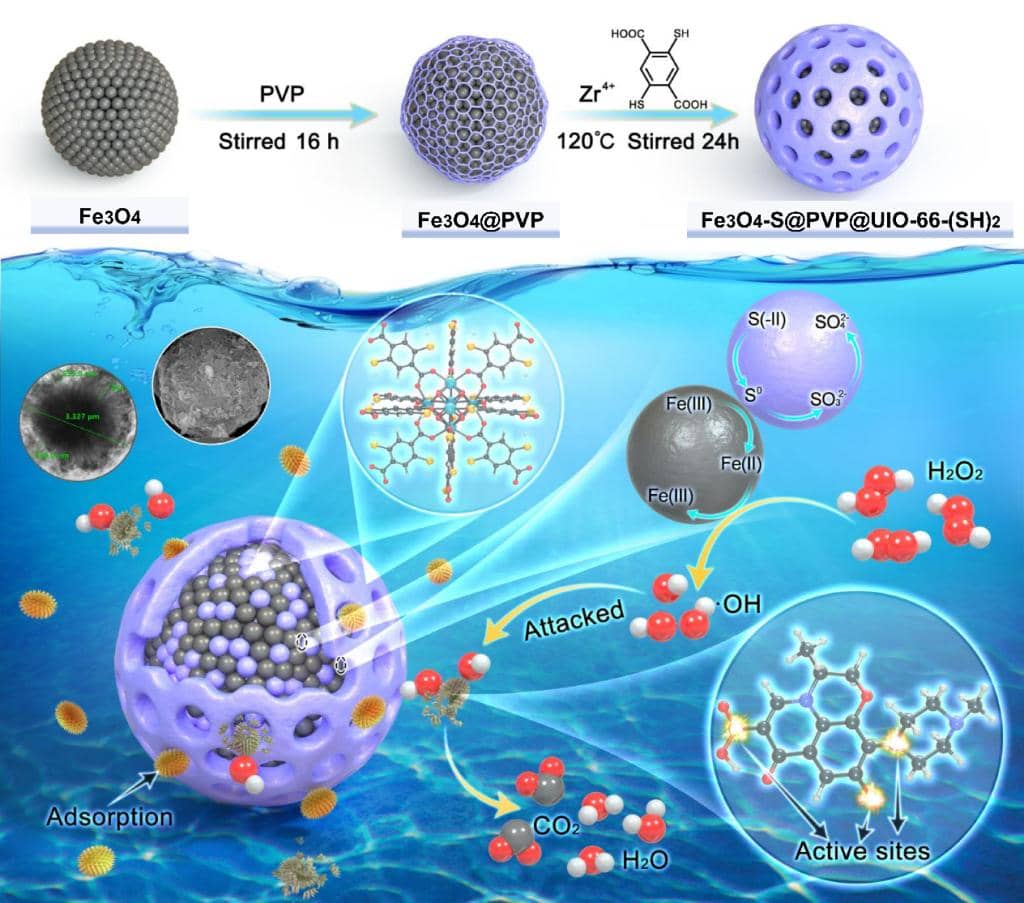The multifunctional metal-organic framework (MOF) materials with core-shell structure and sulfur-doping characteristics were designed for highly efficient adsorption and synergistic degradation of antibacterial drugs. This results were published in the Chemical Engineering Journal as “S-doped core-shell heterojunction fenton catalyst (Fe3O4-S@PVP@UIO-66-(SH)2) for enhanced activation of hydroxyl radical: synergistic enrichment and degradation mechanism”. The low-valence S species was innovatively doped into Fe3O4 in the form of MOF, and a S-doped core-shell heterojunction multiphase fenton catalyst was successfully prepared by a simple one-pot method. Based on the theoretical calculation and experimental results, the mechanism of eliminating the deactivation of the active site of iron by the introduction of non-metals was investigated systematically.
As we all known, antimicrobial residues in the environment pose a serious threat to human and animal health as well as environmental safety through bioaccumulation and biomagnification in the food chain. Therefore,it is of great practical significance and scientific value to explore the rapid and efficient removal technology of antibiotics from water environment. It is an effective method to combine the traditional adsorption technology with the advanced oxidation process based on hydrogen peroxide to remove the refractory antibacterial drugs. In the fenton oxidation process, the rate at which the catalyst activates hydrogen peroxide to produce reactive oxygen species (ROS) and the efficiency of ROS utilization are the two key factors affecting the removal efficiency of antibiotics from the environment. Synergistic adsorption and advanced oxidation process can enrich pollutants rapidly, reduce the deactivation caused by long-distance transport of reactive oxygen species and pollutants, and improve the utilization efficiency of reactive oxygen species.
For these reasons, a core-shell-doped multiphase catalyst with efficient synergistic adsorption and catalysis (Fe3O4-S@PVP@UIO-66-(SH)2) was designed. The UIO-66-(SH)2 located on the shell layer can enrich antibacterial drugs and shorten the migration distance between reactive oxygen species and pollutants, the low-valent sulfur fixed on the surface of the material can restore the Fe3+ in the solution. The Fe3O4 in the core provided the active site of Fe, and the doping of non-metallic sulfur elements in the core can enhance the catalytic performance of the active site of Fe and realize the efficient production of reactive oxygen species. At the same time, the encapsulation of UIO-66-(SH)2 can ensure the stability of sulfur-doped core-shell heterojunction fenton catalyst and reduce the leakage of iron. The interesting magnetic properties of Fe3O4 contribute to the efficient recovery of the catalyst after reaction. In addition, the mechanism of antimicrobial adsorption and degradation were elucidated by density functional theory. This study provides a new idea and a scientific theoretical reference for the application of nonmetal in fenton system, and a new strategy for the construction of heterogeneous fenton catalysts.

Dingtang Li, an undergraduate, is the first author. Professor Dongmei Chen and Professor Shuyu Xie are the co-corresponding authors. Some of other students in the research group participated in the work. The research was funded by the National Key Research and Development Program and Huazhong Agricultural University College Students' Innovation and Entrepreneurship Project.
Link:https://www.sciencedirect.com/science/article/pii/S1385894723036938